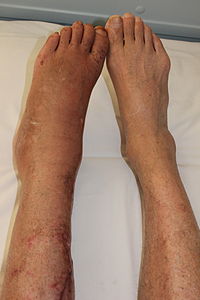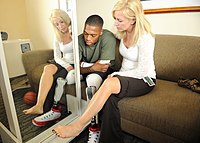
Neural basis of induced phantom limb pain relief
Sign Up to like & getrecommendations! Published in 2019 at "Annals of Neurology"
DOI: 10.1002/ana.25371
Abstract: Phantom limb pain (PLP) is notoriously difficult to treat, partly due to an incomplete understanding of PLP‐related disease mechanisms. Noninvasive brain stimulation (NIBS) is used to modulate plasticity in various neuropathological diseases, including chronic pain.… read more here.
Keywords: limb pain; neural basis; basis induced; phantom limb ... See more keywords

Unveiling the phantom: What neuroimaging has taught us about phantom limb pain
Sign Up to like & getrecommendations! Published in 2022 at "Brain and Behavior"
DOI: 10.1002/brb3.2509
Abstract: Phantom limb pain (PLP) is a complicated condition with diverse clinical challenges. It consists of pain perception of a previously amputated limb. The exact pain mechanism is disputed and includes mechanisms involving cerebral, peripheral, and… read more here.
Keywords: plp; phantom; phantom limb; limb pain ... See more keywords

Mirror therapy for phantom limb pain in moderate intellectual disability. A case report.
Sign Up to like & getrecommendations! Published in 2021 at "European journal of pain"
DOI: 10.1002/ejp.1859
Abstract: BACKGROUND Phantom limb pain (PLP) is a common problem after limb amputation. There is mounting evidence supporting the use of mirror therapy (MT) in the treatment of individuals with PLP. However, there is no research… read more here.
Keywords: limb pain; treatment; case; phantom limb ... See more keywords

Chronic subdural cortical stimulation for phantom limb pain: report of a series of two cases
Sign Up to like & getrecommendations! Published in 2019 at "Acta Neurochirurgica"
DOI: 10.1007/s00701-019-03828-1
Abstract: Phantom limb pain is a complex, incompletely understood pain syndrome that is characterized by chronic painful paresthesias in a previous amputated body part. Limited treatment modalities exist that provide meaningful relief, including pharmacological treatments and… read more here.
Keywords: limb pain; stimulation; phantom limb;

Preliminary Investigation of Pain-Related Changes in Cerebral Blood Volume in Patients With Phantom Limb Pain.
Sign Up to like & getrecommendations! Published in 2017 at "Archives of physical medicine and rehabilitation"
DOI: 10.1016/j.apmr.2017.03.010
Abstract: OBJECTIVE To investigate changes in the pain network associated with phantom limb pain, magnetic resonance imaging (MRI) was used to measure cerebral blood volume (CBV) in patients who had undergone unilateral arm amputation after electrical… read more here.
Keywords: limb pain; volume; cortex; cbv ... See more keywords

Neural correlates of evoked phantom limb sensations
Sign Up to like & getrecommendations! Published in 2017 at "Biological Psychology"
DOI: 10.1016/j.biopsycho.2017.04.009
Abstract: Highlights • We present a neural network related to evoked phantom sensations in amputees.• Such networks were not related to the stimulation from the residual limb.• Difference in intra- and inter-hemispheric interactions between amputees and… read more here.
Keywords: limb sensations; correlates evoked; limb; evoked phantom ... See more keywords

Understanding intracortical excitability in phantom limb pain: A multivariate analysis from a multicenter randomized clinical trial
Sign Up to like & getrecommendations! Published in 2021 at "Neurophysiologie Clinique"
DOI: 10.1016/j.neucli.2020.12.006
Abstract: OBJECTIVES To explore associations of intracortical excitability with clinical characteristics in a large sample of subjects with phantom limb pain (PLP). METHODS Ancillary study using baseline and longitudinal data from a large multicenter randomized trial… read more here.
Keywords: plp; intracortical excitability; excitability; phantom limb ... See more keywords

Effectiveness of mirror therapy in phantom limb pain: a literature review
Sign Up to like & getrecommendations! Published in 2018 at "Neurologia"
DOI: 10.1016/j.nrleng.2018.08.005
Abstract: Abstract Introduction Phantom limb pain (PLP) is a type of neuropathic pain that affects the territory of an amputated limb or other surgically removed body parts. Between 60% and 90% of amputees suffer from PLP… read more here.
Keywords: plp; mirror therapy; review; phantom limb ... See more keywords

[Psychotherapies for the Treatment of Phantom Limb Pain].
Sign Up to like & getrecommendations! Published in 2017 at "Revista colombiana de psiquiatria"
DOI: 10.1016/j.rcp.2016.08.003
Abstract: INTRODUCTION The phantom limb pain has been described as a condition in which patients experience a feeling of itching, spasm or pain in a limb or body part that has been previously amputated. Such pain… read more here.
Keywords: limb pain; limb; phantom limb; treatment phantom ... See more keywords

Use of virtual reality for the management of phantom limb pain: a systematic review.
Sign Up to like & getrecommendations! Published in 2023 at "Disability and rehabilitation"
DOI: 10.1080/09638288.2023.2172222
Abstract: PURPOSE To summarize the research on the effectiveness of virtual reality (VR) therapy for the management of phantom limb pain (PLP). METHODS Three databases (SCOPUS, Ovid Embase, and Ovid MEDLINE) were searched for studies investigating… read more here.
Keywords: limb pain; therapy; phantom limb; reality ... See more keywords

Detangling the structural neural correlates associated with resting versus dynamic phantom limb pain intensity using a voxel-based morphometry analysis.
Sign Up to like & getrecommendations! Published in 2022 at "Pain medicine"
DOI: 10.1093/pm/pnac205
Abstract: The management of phantom limb pain (PLP) is still challenging due to a partial understanding of its neurophysiological mechanisms. Structural neuroimaging features are potential biomarkers. However, only a few studies assessed their correlations with clinical… read more here.
Keywords: limb; phantom limb; severity; pain ... See more keywords